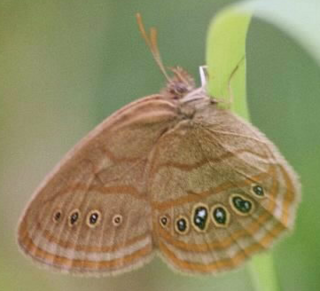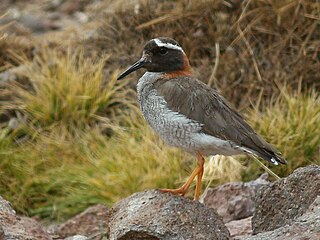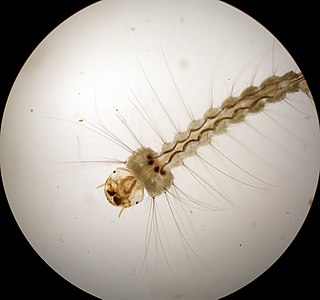
A mosquito is any member of a group of about 3,500 species of small insects belonging to the order Diptera (flies). Within Diptera, mosquitoes constitute the family Culicidae. The word "mosquito" is Spanish and Portuguese for "little fly". Mosquitoes have a slender segmented body, one pair of wings, one pair of halteres, three pairs of long hair-like legs, and elongated mouthparts.

The Saint Francis' satyr is an endangered butterfly subspecies found only in the US state of North Carolina. First discovered in 1983, it was first described by David K. Parshall and Thomas W. Kral in 1989 and listed as a federally endangered species by the US Fish and Wildlife Service in 1994. It is a subspecies of N. mitchellii and is restricted to a single metapopulation on Fort Bragg military base in Hoke and Cumberland counties. The other subspecies, Mitchell's satyr, is also federally endangered.

Catopsis berteroniana, commonly known as the powdery strap airplant, is an epiphytic bromeliad thought to be a possible carnivorous plant, similar to Brocchinia reducta, although the evidence is equivocal. Its native range is from southern Florida to southern Brazil. It generally grows on the unshaded twigs of trees, and has been shown experimentally to trap more insects in its tank than other bromeliads of comparable size. There are several other species in the genus, none of which is believed to be carnivorous.

The Pacific-slope flycatcher is a small insectivorous bird of the family Tyrannidae. It is native to coastal regions of western North America, including the Pacific Ocean and the southern Gulf of California, as far north as British Columbia and southern Alaska, but is replaced in the inland regions by the Cordilleran flycatcher. These two species were classified as a single species, commonly called the western flycatcher, by the American Ornithologists’ Union until 1989. In winter, both species migrate south to Mexico, where they are virtually indistinguishable from one another.

Crotalus mitchellii is a venomous pit viper species in the family Viperidae. The species is endemic to the Southwestern United States and adjacent northern Mexico. The species was named in honor of Silas Weir Mitchell (1829–1914), an American medical doctor who also studied rattlesnake venoms. Five subspecies are currently recognized, including the nominate subspecies described here.

The Culicinae are the most extensive subfamily of mosquitoes (Culicidae) and have species in every continent except Antarctica, but are highly concentrated in tropical areas. Mosquitoes are best known as parasites to many vertebrate animals and vectors for disease. They are holometabolous insects, and most species lay their eggs in stagnant water, to benefit their aquatic larval stage.

Orthobunyavirus is a genus of the Peribunyaviridae family in the order Bunyavirales. There are currently ~170 viruses recognised in this genus. These have been assembled into 97 species and 20 serogroups.

The diademed sandpiper-plover or diademed plover is a species of bird in the plover family Charadriidae. It is monotypic within the genus Phegornis. The relationship of this species to other plovers is uncertain, a 2010 study suggested it may be related to the Australian dotterels.
Crotalus mitchellii muertensis is a venomous pitviper subspecies endemic to El Muerto Island, Mexico. It is sometimes treated as a full species, Crotalus muertensis.

Wyeomyia smithii, the pitcher plant mosquito, is an inquiline mosquito that completes its pre-adult life cycle in the phytotelma—that is, the water contained by the purple pitcher plant, Sarracenia purpurea. In this microcommunity of bacteria, rotifers, protozoa, and midges, W. smithii is the top-level predator; its presence determines the bacterial species diversity within the pitcher. It is not in any way a pest mosquito, neither biting nor approaching humans or livestock, although there are some populations in the southern US, such as that in the Apalachicola National Forest, that have been observed to take blood meals after laying an initial egg batch. In fact, it is the only known mosquito to have both obligatory biting and non-biting populations in the same species.

Hakea mitchellii, commonly known as desert hakea, is a shrub species in the family Proteaceae.

Conospermum mitchellii, commonly known as Victorian smokebush is a shrub which is endemic to Western Victoria, Australia. It grows to between 1 and 2 metres high and has linear leaves that are 5 to 20 cm long and 0.8 to 3.5 mm wide. The flowers are bluish-grey in bud and open to white. These appear between July and December in its native range.
Anhembi orthobunyavirus, formerly simply Anhembi virus (AMBV), is a species of virus. It was initially considered a strain of Wyeomyia virus, belonging serologically to the Bunyamwera serogroup of bunyaviruses. In 2018 it was made its own species. It was isolated from the rodent - Proechimys iheringi - and a mosquito - Phoniomyia pilicauda - in São Paulo, Brazil.

Wyeomyia is a genus of mosquitoes first described in 1901 by Frederick Vincent Theobald. The genus's 140 species can be difficult to characterize because of their diversity and the need for additional taxonomic work to further delineate them. Adults resemble genus Limatus and Sabethes mosquitoes more closely than other genera in the New World tribe Sabethini, but differ by their scutal scales ranging in color from a relatively dull bronzy with a slight metallic sheen in most species, to a metallic gold. There are other distinguishing characters as well.
Nunezia is a subgenus of the mosquito genus Wyeomyia. It was named to honor the Venezuelan entomologist Manuel Núñez Tovar.

Wyeomyia vanduzeei is a species of mosquito in the family Culicidae.

Deinocerites cancer, the crabhole mosquito, is a species of mosquito in the family Culicidae.
Anopheles atropos is a species of mosquito in the family Culicidae.












